From Novice to Yogi: The Ultimate Guide for Yoga Beginners
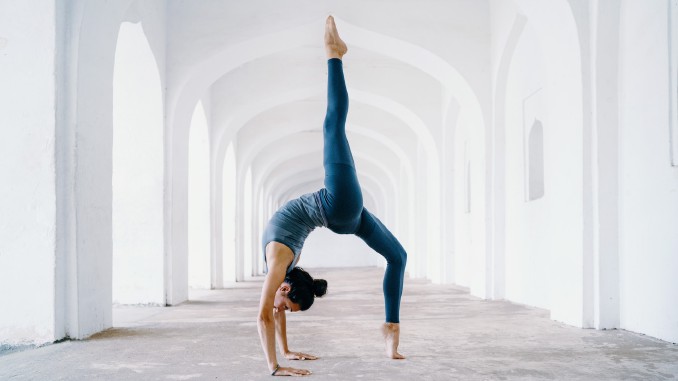
Let’s dive into the world of yoga, a practice that has stood the test of time, offering a slice of calm in our otherwise hectic lives. Originating in ancient India over 5,000 years ago, yoga has been a companion to those seeking physical, mental, and spiritual well-being.
It started off as a way to unite the human spirit with divine consciousness, and while it has morphed over centuries, this core essence still shines through.
Fast forward to today, and yoga is more relevant than ever. Our lives are busier, stress levels are higher, and finding a moment of peace can sometimes feel like a treasure hunt.
Yoga offers that space to breathe, to stretch out the kinks in our bodies, and to smooth out the wrinkles in our minds. It’s not just about twisting into pretzel shapes but also about finding balance, literally and metaphorically.
Now, let’s talk benefits, and trust me, there are plenty. On a physical level, yoga is like a good friend to our bodies.
It helps in improving flexibility, strength, and even posture. So, those aches and pains from sitting at a desk all day? Yoga offers a solution for that. It’s gentle on the body while still providing a solid workout.
On the mental front, yoga is a champion for reducing stress and anxiety. It encourages mindfulness, helping us to tune out the noise of the outside world and tune into ourselves. Imagine being able to hit the mute button on life’s stresses, even if just for a little while. That’s what yoga can do.
And then there’s the spiritual aspect. Yoga isn’t tied to any religion; instead, it offers a path to explore and connect with our own inner selves. It’s about finding that quiet center within, no matter what’s happening around us.
So, in a world where we’re constantly racing against deadlines and battling to-do lists, yoga offers a pause. It’s more than just a physical practice; it’s a tool for self-discovery and a practice that encourages us to take a breather, to reflect, and to connect with ourselves on a deeper level.
The beauty of yoga is that it’s an invitation to explore, to breathe, and to just be. And that’s something we could all use a little more of in our lives, don’t you think?
The term “Yoga” derived from the Sanskrit word “Yuj”, epitomizes the union of body and consciousness, establishing a harmonious dialogue between the two. The practice has evolved through ages, intertwining with various cultures, yet retaining its core essence of promoting holistic wellness.
Understanding the Foundations of Yoga

Yoga is more than just bending and stretching on a mat; it’s a deep and enriching philosophy that encompasses how we interact with the world, ourselves, and the divine.
Let’s unravel the essence of Yoga through its eight limbs, breaking them down into a simple narrative that resonates with everyone.
1. Yamas
The journey begins with Yamas, the ethical standards or the moral disciplines. They are the guidelines for how we should interact with the outside world, kind of like the golden rules we learn as kids.
For instance, practicing non-violence (not hurting others), truthfulness (being honest), and non-stealing (not taking what doesn’t belong to us). These principles help in creating a positive external environment.
2. Niyamas
Next, we have Niyamas, the rules for self-discipline, focusing on our inner world. They encompass cleanliness (keeping our bodies and surroundings clean), contentment (being happy with what we have), and self-study (learning about ourselves and our behaviors).
They’re like the personal chores and habits that keep our inner world tidy and harmonious.
3. Asana
Now, let’s touch upon the more known aspect, Asana, the physical postures. This is where we get to move, stretch, and strengthen our bodies.
It’s not just about touching your toes but about creating a balance between the mind and body. Through various postures, we learn to listen to our bodies, understand its capabilities, and also its limitations.
4. Pranayama
Moving on to Pranayama, or breath control, it’s like learning to play a wind instrument, where your body is the instrument and your breath is the music.
Through different breathing exercises, we learn to control our breath, which in turn helps in calming the mind and energizing the body.
It’s amazing how a simple act of breathing right can have such a profound impact on our well-being.
5. Pratyahara
The next limb, Pratyahara, is about the withdrawal of the senses. It’s like closing the doors to outside distractions and turning inward. By doing this, we learn to observe our thoughts and emotions rather than being controlled by them.
6. Dharana
Then we have Dharana, which focuses on concentration. It’s about training the mind to focus on a single point, like a candle flame or a specific thought, and keep returning to that focus whenever the mind wanders off. It’s like training wheels for the mind before diving into the deeper waters of meditation.
7. Dhyana
The seventh limb, Dhyana, is meditation. It’s a step up from Dharana, moving from concentration to a state of being aware without focus. It’s about observing thoughts and emotions without attachment, like watching clouds pass by in the sky.
8. Samadhi
Lastly, Samadhi, the state of ecstasy or enlightenment, is the final destination in the yoga journey. It’s about merging with the divine and feeling oneness with the universe.
It’s like finding your spot in the vast cosmos—a sense of complete peace and understanding.
The Eight Limbs of Yoga act like a roadmap, guiding us through a journey of self-discovery, harmony, and ultimate union with the divine. It’s not a one-day trip but a lifelong adventure towards a holistic and enriching life.
Types of Yoga
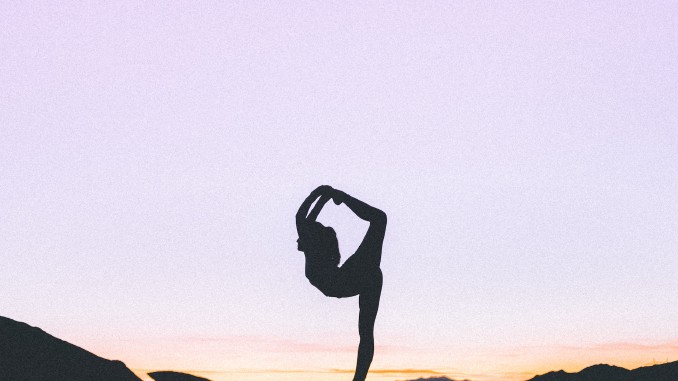
Yoga is a rich tapestry with many threads, each representing a unique style with its own benefits and focus. Let’s delve into the distinctive elements of various yoga styles, unraveling the essence of each to help you find your fit in this expansive yoga landscape.
Hatha Yoga: The Foundational Stone
Hatha Yoga is often considered the foundation from which many other styles have evolved. Rooted in the basics, it’s a gentle introduction to the world of yoga, making it an ideal choice for beginners. The practice revolves around mastering the basics of asanas (postures) and pranayama (breath control), setting a strong foundation for a fruitful yoga journey. It’s like learning the alphabet before diving into the intricacies of language.
The sessions in Hatha Yoga are generally slow-paced, giving ample time to explore each posture and understand the alignment. It’s a practice that invites you to tune in, nurturing a dialogue between the body and mind. The emphasis on breath also fosters a serene atmosphere, guiding the mind to a calm and centered state.
Hatha Yoga serves as a powerful tool to foster flexibility, strength, and mental clarity. By dedicating time to this practice, you pave the way for a deeper exploration of what yoga has to offer. It’s akin to laying down the first bricks with precision and understanding, ensuring the stability of the majestic structure of your yoga practice that is yet to unfold.
Vinyasa Yoga: The Fluid Dance
Vinyasa, often known as “flow” yoga, is characterized by its fluid transition from one posture to another, synchronized with the breath. It’s like a rhythmic dance where each movement is a beat that creates a harmonious melody. The continuous flow makes Vinyasa a dynamic and exhilarating practice that can be a good match for individuals looking for a more vigorous workout.
The beauty of Vinyasa lies in its diversity. There isn’t a fixed sequence, which means each class could be a new adventure. The creative sequencing orchestrated by the instructor keeps the practice engaging and allows an exploration of various postures and transitions.
The emphasis on syncing breath with movement cultivates a moving meditation. Each inhalation and exhalation guides the flow, fostering a deep sense of presence and mindfulness. The rhythm of breath acts like a thread that weaves through the sequence, creating a tapestry of mindful movement.
Ashtanga Yoga: The Structured Endeavor
Ashtanga Yoga is a more regimented version of yoga, known for its structured sequence of postures that are performed in the same order every time. It’s like a disciplined school where adherence to the sequence is the key to progression. The practice is intense and dynamic, offering a vigorous workout while cultivating mental focus and discipline.
The sequential nature of Ashtanga cultivates a deep sense of rhythm and routine. Each posture paves the way for the next, creating a seamless flow that reflects a well-orchestrated symphony. This structure allows practitioners to focus on perfecting each pose over time, fostering a deep sense of achievement and progression.
Plus, the practice of Ashtanga can be meditative in nature. The repetition allows for an inward journey where the rhythmic flow becomes a moving meditation. The challenges posed by the structured sequence foster resilience and determination, crafting a journey that is as enriching for the mind as it is for the body.
Iyengar Yoga: The Pursuit of Precision
Iyengar Yoga, named after its founder, B.K.S. Iyengar, is all about precision and alignment. It’s like an architect meticulously ensuring that every angle and structure are perfect. This style of yoga dives deep into the nuances of each posture, using props like belts, blocks, and ropes to achieve precise alignment.
The slow pace and the emphasis on holding poses for an extended period allow for a deeper understanding of each asana. It’s an invitation to explore the body’s mechanics, understanding how each muscle and joint contributes to posture. The props act as supportive tools, making the practice accessible to individuals irrespective of their flexibility or experience.
Iyengar Yoga is also a boon for those recovering from injuries or dealing with chronic conditions. The use of props provides a safe environment to explore yoga without straining the body. Furthermore, the focus on alignment promotes better posture and body awareness, which can be a gateway to improved physical health and a deeper understanding of the body’s intricacies.
Kundalini Yoga: The Spiritual Uplift
Kundalini Yoga is often seen as a path to spiritual awakening, focusing on unleashing the dormant energy at the base of the spine. It’s like a mystical journey that combines postures, breathwork, mantra chanting, and meditation to ignite the inner fire.
Each session in Kundalini Yoga is designed to elevate the spirit, fostering a transcendent experience. The unique blend of physical and spiritual elements cultivates a holistic practice that nurtures the body, mind, and soul. It’s about diving into the unknown realms of consciousness and exploring the mystic energy that resides within.
The practice of Kundalini can be transformative, often leading to profound experiences of awakening and clarity. The awakening and clarity nurtured through Kundalini Yoga can translate into a heightened sense of purpose and a deeper understanding of one’s place in the cosmos. It’s a path that beckons the curious and spiritual seekers, offering a voyage into the depths of the self.
Bikram/Hot Yoga: The Sweaty Embrace
Bikram Yoga, or commonly known as Hot Yoga, turns up the heat, literally. Practiced in a room heated to around 105°F with a humidity of 40%, it’s like stepping into a sauna where yoga meets sweat. The practice consists of a sequence of 26 postures and two breathing exercises, each performed twice in a 90-minute class.
The heat is not just a gimmick; it helps loosen up the muscles and joints, allowing for a deeper stretch. It’s like giving your body a warm embrace, making it easier to move, bend, and stretch. The sweat is part of the detoxification process, helping to flush out toxins through the skin.
Also, Bikram Yoga offers a robust workout. The combination of heat and the sequence of postures challenges the body, enhancing strength, flexibility, and endurance. It’s a practice that demands dedication and focus, often leaving practitioners with a sense of accomplishment and a good sweat.
Yin Yoga: The Gentle Whisper
Yin Yoga is like a gentle whisper amidst the bustling chatter of other yoga styles. It’s a slower-paced practice where postures are held for longer periods, often between 3 and 5 minutes. The focus here is on the connective tissues, like ligaments and fascia, rather than the muscles.
The extended hold in each posture offers a space for quiet reflection and relaxation. It’s like taking a leisurely stroll through your inner landscape, exploring the sensations, emotions, and thoughts that arise. The practice fosters a deep sense of stillness and mindfulness, allowing for a meditative experience.
Yin Yoga is a beautiful practice to balance the energetic and fiery nature of other yoga styles or life’s hectic pace. It’s an invitation to slow down, to turn inward, and to cultivate a sense of peace and acceptance. The gentle nature of Yin Yoga makes it a wonderful practice for relaxation, stress reduction, and emotional healing.
Restorative Yoga: The Nurturing Retreat
Restorative Yoga is about slowing down and opening the body through passive stretching. It’s like sinking into a comforting embrace, allowing the body and mind to relax and rejuvenate. In this style, postures are held for an extended period, but unlike Yin Yoga, the focus is on relaxation rather than stretching.
Props like bolsters, blankets, and blocks are used to support the body in various poses, allowing for a complete surrender. It’s like having a soft cushion that holds you gently as you let go of tension and stress. The calm and soothing environment of a Restorative Yoga class is a fertile ground for relaxation and reflection.
Restorative Yoga is a balm for the nervous system. The gentle and supportive nature of the practice promotes a state of relaxation, which can be a gateway to reducing stress, anxiety, and insomnia. It’s a practice that nurtures the body and cradles the mind, leading to a state of profound relaxation and peace.
Prenatal Yoga: The Motherly Embrace
Prenatal Yoga is tailored for the beautiful journey of pregnancy, offering a supportive environment for expectant mothers. It’s like having a gentle companion guiding you through the physical and emotional changes that accompany pregnancy. The practice focuses on poses that enhance strength, flexibility, and balance, preparing the body for childbirth.
The classes also provide a space for mothers-to-be to connect with their babies and with other expectant mothers, creating a community of support. It’s like joining a nurturing circle that understands and shares the unique joys and challenges of pregnancy.
Prenatal Yoga emphasizes breathing and relaxation techniques that can be invaluable during labor and childbirth. It’s a practice that empowers women, providing tools to navigate through the journey of pregnancy and motherhood with grace, strength, and serenity.
Other Styles: The Creative Spectrum
The realm of yoga is expansive, with creative and modern adaptations like AcroYoga, Chair Yoga, and Aerial Yoga, to name a few. AcroYoga, for instance, is a playful blend of yoga and acrobatics, encouraging teamwork and trust as practitioners explore poses in pairs or groups. It’s like adding a playful, collaborative twist to the traditional practice.
Chair Yoga makes the practice accessible to those with mobility issues, utilizing a chair for support in various poses. It’s a gentle way to introduce movement and yoga’s benefits, irrespective of physical limitations.
Each style within the yoga spectrum offers a unique flavor, whether it’s the playful interaction of AcroYoga, the accessibility of Chair Yoga, or the floating freedom of Aerial Yoga. These modern adaptations showcase yoga’s versatility and its ability to evolve, making the practice inclusive and engaging.
Finding Your Yoga Fit
The diverse landscape of yoga offers a rich selection to cater to different preferences, needs, and lifestyles. Choosing a style that resonates with you is akin to finding a home that fits—it should feel comfortable, inviting, and right for your current life phase.
Consider your personal goals, whether it’s building strength, promoting relaxation, or embarking on a spiritual journey. It could also be beneficial to consult with yoga instructors or try out different styles to get a taste of what each offers.
Yoga is a personal journey. It’s about exploring, experiencing, and finding what feels right for you. So, dive in, explore the myriad styles, and embrace the journey towards finding your yoga haven.
Choosing the Right Yoga Gear
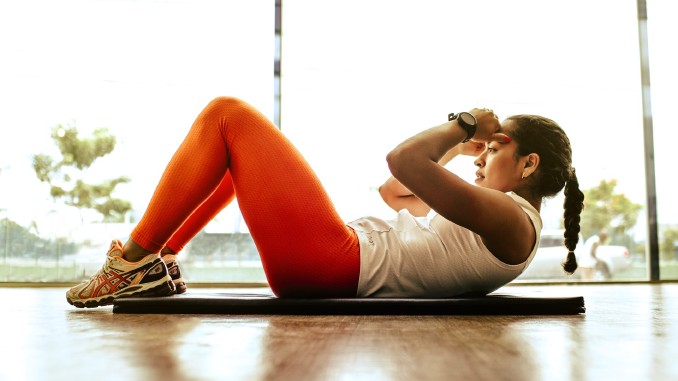
Embarking on a yoga journey is a deeply personal and transformative experience. The right gear can significantly enhance this journey by ensuring comfort, support, and safety as you explore various poses and techniques.
Yoga is a practice that emphasizes the harmony between mind and body, and having the appropriate gear fosters a conducive environment for this connection.
High-quality, well-chosen yoga equipment can provide the necessary support, aiding in the correct alignment of the body, which is crucial for both the effectiveness and safety of the practice.
Also, the right gear can instill a sense of confidence and motivation in beginners, making the practice more enjoyable and sustainable.
Investing in the right yoga gear is also a reflection of your commitment to your practice and self-care. Each piece of equipment, be it a yoga mat, blocks, straps, or even the clothing you wear, serves a distinct purpose aimed at enhancing your practice.
For instance, a good yoga mat provides the necessary cushioning and grip essential for executing poses correctly and safely. Yoga blocks and straps are instrumental in making the practice more accessible, especially for beginners who might not have the flexibility or strength initially.
Plus, wearing comfortable and breathable yoga attire allows for unrestricted movement, enabling a more focused and unobstructed practice.
Yoga Mat
A yoga mat is like a personal space for doing yoga. It’s a long, thin, cushioned pad that you roll out on the floor.
When you stand or sit on it, it gives you some cushioning so you’re not right on the hard floor, and it also gives you a grippy surface so you don’t slip while doing your poses.
It’s your own little area to stretch, move, and relax during your yoga practice. A good yoga mat can make your session more comfortable and enjoyable, helping you focus on your yoga instead of feeling uncomfortable or sliding around.
- Look for a mat that is at least 6mm thick for cushioning and comfort.
- Examples: Gaiam Essentials Thick Yoga Mat, Manduka PRO Yoga Mat.
Yoga Blocks
Yoga blocks are handy little helpers in your yoga practice. They are firm, rectangular blocks, usually made of foam, cork, or wood, that you can use to support different parts of your body while you’re learning new poses or trying to stretch a bit further.
For example, if you can’t quite reach the ground in a certain pose, you can rest your hand on a yoga block instead.
They help make yoga easier and more comfortable, especially if you’re just starting out. By using yoga blocks, you can gradually improve your flexibility and strength, making it easier to do your yoga poses with good form and alignment.
- These can help with flexibility and provide support during poses.
- Examples: Gaiam Essentials Yoga Block (Set of 2), Hugger Mugger Cork Yoga Block.
Yoga Strap
A yoga strap is your friendly helper that extends your reach during your yoga practice. It’s a long, sturdy band made of cotton or nylon with a buckle or loop at the end, which you can adjust to the length you need.
If you’re trying to hold a foot or hand in a certain pose but can’t quite reach it, you can loop the strap around your foot or hand and hold onto the other end of the strap to make it easier. It’s a great tool for gently stretching and opening up your body, especially if you’re not super flexible yet.
Yoga straps help you stretch in a safer and more controlled way, helping you to gradually improve your flexibility and master your yoga poses with better form and alignment. Plus, they’re really simple to use, making them a great tool for yoga beginners to start exploring and enjoying their yoga practice.
- A yoga strap can assist with stretching and help to slowly build flexibility.
- Examples: Gaiam Yoga Strap, Manduka Align Yoga Strap.
Yoga Bolster
A yoga bolster is a firm, cushioned support used during yoga and meditation practices. It’s similar to a stuffed pillow but is denser and often has a cylindrical or rectangular shape.
When you’re doing certain yoga poses or simply sitting for meditation, a yoga bolster can provide comfort and support to different parts of your body such as your back, neck, or legs.
It helps in maintaining good posture, allowing for deeper relaxation and better breathing. By using a yoga bolster, you can make your yoga or meditation practice more comfortable, and it can also help in easing into stretches gently, making it especially useful for restorative yoga sessions.
- Bolsters provide support during restorative poses and meditation.
- Examples: Hugger Mugger Standard Yoga Bolster, Gaiam Yoga Bolster.
Yoga Blanket
A yoga blanket is a versatile accessory used in yoga practice. It’s a thick, durable blanket that you can fold, roll, or stack to provide extra support and cushioning during certain yoga poses.
For example, you might sit on a folded yoga blanket to lift your hips during seated poses or use it under your knees or elbows for added comfort.
Besides support, yoga blankets are great for keeping you warm during relaxation or meditation sessions at the end of your practice.
They can also be used to cover your eyes or body, helping you relax deeper. The yoga blanket is helpful for making your yoga practice more comfortable and enjoyable, allowing you to focus on your movements and breath.
- It provides cushioning and support and can also keep you warm during relaxation.
- Examples: El Paso Designs Mexican Yoga Blanket, Benevolence LA Mexican Blanket.
Yoga Pants
Yoga pants are the comfy, stretchy pants you wear when you’re doing yoga. They are made from soft, flexible materials such as spandex or cotton, which allow you to move freely in all directions.
They fit snugly but not too tight, so they move with you as you stretch, bend, and twist through your yoga poses. Most have a wide waistband, which helps them stay put, and they come in various styles like full-length, capris, or even shorts.
They’re designed to keep you comfortable and covered, making your yoga practice a breeze. Plus, they’re stylish enough for a quick coffee run before or after your yoga session!
- Comfortable and stretchable pants are crucial for a good yoga practice.
Examples:
- IUGA High Waist Yoga Pants (for women)
- Willit Men’s Active Yoga Leggings Pants (for men)
- ODODOS Out Pocket High Waist Yoga Pants (for women)
- COOFANDY Mens Linen Loose Pant (for men)
Books on Yoga
Diving into yoga as a beginner can feel like stepping into a new world, and having a good book can serve as a map through this uncharted territory. Books on yoga offer a wealth of knowledge right at your fingertips.
They explain the basics, the different styles of yoga, and the philosophy behind it, and they often come with pictures or illustrations to guide you into getting the poses just right. They are your go-to guide for when you’re practicing at home and want to ensure you’re doing things correctly.
Plus, they provide insights and tips to deepen your understanding and enhance your practice, making the journey of yoga more meaningful and enjoyable. They are a quiet companion you can turn to at any time, helping you grow in your practice at your own pace.
Whether you’re looking to understand the alignment in poses, the breathing techniques, or just the yoga lifestyle, a good yoga book has got your back.
- Reading up on yoga can provide valuable insights and tips for beginners.
- Examples: “The Heart of Yoga: Developing a Personal Practice” by T.K.V. Desikachar, “Light on Yoga” by B.K.S. Iyengar.
Starting with the Basics
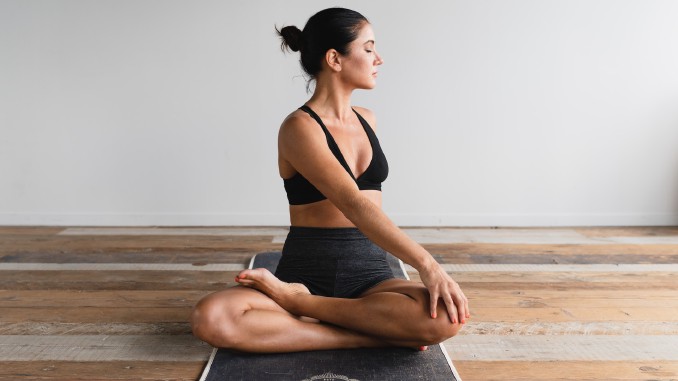
A well-designated yoga space provides a sanctuary where your practice can flourish away from the distractions of daily life. Here’s a simple guide to setting up a conducive yoga space:
Setting Up a Yoga Space at Home
- Find a Quiet Corner: Locate a quiet and calm corner in your home where you won’t be disturbed. It doesn’t have to be a large space, but it should be comfortable enough for you to move freely.
- Keep it Clean and Clear: Maintain a clean and clutter-free space to help maintain a clear mind. A tidy space is inviting and will motivate you to practice regularly.
- Personalize Your Space: Add a personal touch with items that inspire tranquility and positivity. Perhaps some plants, a few pieces of artwork, or a small altar. Make it a place you look forward to spending time.
Embarking on Physical Practice: Fundamental Postures
Now that you have your space ready, it’s time to acquaint yourself with some fundamental yoga postures that are ideal for beginners.
Mountain Pose (Tadasana)
This is a grounding pose that teaches basic alignment and engages your whole body.
Mountain Pose, or Tadasana, is often perceived as a simple standing posture, but when delved into, it’s a foundational pose that carries a lot of essence and benefits. Here’s a more detailed exploration of Mountain Pose, how to perform it, and the benefits it brings along.
How to do the Mountain Pose:
- Finding Your Ground: Begin by standing barefoot on a yoga mat or a firm surface. Spread your toes wide and root down through all four corners of your feet—the base of your big toes, the base of your pinky toes, and the two outer edges of your heels.
- Aligning Your Body: As you stand tall, engage your thighs slightly to lift your kneecaps gently without hyper-extending your knees. Keep your pelvis neutral, and lengthen your tailbone towards the floor.
- Lifting Upwards: Imagine a string attached to the top of your head pulling you upwards. Let this idea help you lift your chest, lengthen your spine, and reach the crown of your head towards the sky.
- Relaxing Your Shoulders: Roll your shoulders up towards your ears, then back and down. Let them settle away from your ears, with your arms hanging naturally by your sides and your palms facing forward or slightly towards your body.
- Focusing Your Gaze: Soften your gaze or close your eyes, and take several deep breaths. Feel the groundedness through your feet and the elongation of your spine.
The Benefits of the Mountain Pose:
- Foundation for Other Poses: Tadasana is often the starting point for other standing poses. It teaches you the basic alignment that is crucial for many other yoga postures.
- Improves Posture: Practicing Mountain Pose helps improve your posture by aligning the spine, and it educates the body on the correct standing posture.
- Strengthens Muscles: It engages the muscles of your legs, abdomen, and back, thus promoting strength and stability.
- Enhances Body Awareness: The pose helps in enhancing your body awareness and attention to your breath, which is beneficial in calming the mind and reducing stress.
- Therapeutic for Flat Feet: By spreading the toes and grounding through the feet, Tadasana can also be therapeutic for individuals with flat feet.
- Encourages Mindfulness: The simplicity of Mountain Pose provides a perfect opportunity to tune in to your body and breath, encouraging mindfulness and a sense of inner calm.
Mountain Pose is a seemingly simple yet powerful posture that lays the groundwork for a flourishing yoga practice.
As you stand in Tadasana, you’re not just standing; you are grounding, aligning, strengthening, and tuning into a state of centered awareness.
It’s a pose that embodies the essence of stillness in action, setting a solid foundation for your journey through yoga.
Downward Facing Dog (Adho Mukha Svanasana)
This pose stretches the back, legs, and arms, providing a gentle inversion and a moment of rejuvenation.
Downward Facing Dog, or Adho Mukha Svanasana, is one of the most recognized and practiced yoga poses around the globe. This pose is not only a great stretch but also a fundamental part of many yoga sequences.
Let’s dive into how to perform this iconic pose and the multitude of benefits it offers.
How to do the Downward Facing Dog Pose:
- Starting Position: Begin on your hands and knees. Position your wrists directly under your shoulders and your knees under your hips.
- Lift and Extend: Tuck your toes under and slowly lift your hips towards the ceiling as you straighten your legs and arms. Aim to form an inverted ‘V’ shape with your body.
- Adjusting Your Pose: Spread your fingers wide and press down through your palms and knuckles. Keep a slight bend in your elbows to avoid hyperextension. Adjust your feet so they are hip-width apart and parallel, with your heels reaching towards the floor.
- Engaging Your Muscles: Engage your thigh muscles to lift them up towards your hips as you press your heels gently towards the floor. Draw your shoulder blades away from your ears, keeping your head between your arms.
- Hold and Breathe: Hold the pose for a few breaths or as long as it feels comfortable. Feel the stretch along your spine, arms, and legs, and maintain a steady, rhythmic breath.
The Benefits of the Downward Facing Dog Pose:
- Full Body Stretch: Downward Facing Dog is a stellar pose for stretching the spine, shoulders, hamstrings, and calves. It’s like a refreshing stretch for your entire body.
- Strengthens Muscles: The pose engages the muscles in your arms, legs, and core, promoting overall body strength and stability.
- Enhances Circulation: Being an inversion, it encourages blood flow to the brain, which can help in improving mental clarity and reducing stress.
- Promotes Alignment: It’s a great pose to learn about body alignment and awareness, setting a good foundation for other poses.
- Therapeutic Qualities: Practitioners find relief from headaches, insomnia, and fatigue when incorporating this pose into their routine. It’s also known to be therapeutic for mild depression.
- Energizes the Body: The invigorating stretch and improved circulation can be quite energizing, making it a great pose to combat sluggishness.
Downward Facing Dog is a versatile and beneficial pose that finds its way into many yoga practices, whether as a part of a warm-up, a transition between poses, or a restorative stretch.
By embracing the many facets of Adho Mukha Svanasana, you not only stretch and strengthen your body but also invite a sense of balance and rejuvenation into your yoga practice.
Cat-Cow Pose (Marjaryasana-Bitilasana)
A wonderful way to warm up the spine and begin to explore movement and synchronization with breath.
The Cat-Cow Pose, a blend of Marjaryasana (Cat Pose) and Bitilasana (Cow Pose), is a gentle sequence of two postures that warm up the spine and body.
It’s often utilized as a starting point in yoga practices to get the body moving and to begin connecting with the breath. Here’s how you can flow through Cat-Cow Pose and the benefits it brings:
How to do the Cat-Cow Pose:
- Starting Position: Begin on your hands and knees in a tabletop position. Ensure your wrists are directly under your shoulders and your knees are under your hips.
- Moving into Cow Pose (Bitilasana): As you inhale, dip your back down towards the floor and lift your head and tailbone towards the ceiling. Allow your belly to sink towards the floor as you broaden across your shoulder blades.
- Transitioning to Cat Pose (Marjaryasana): On the exhale, round your spine up towards the ceiling, tucking your chin to your chest, and draw your belly button towards your spine. Let your head drop down, but don’t force it.
- Continue the Flow: Continue to flow between Cow Pose on the inhales and Cat Pose on the exhales, moving at your own pace. Let your movement be fluid and your breath steady.
The Benefits of the Cat-Cow Pose:
- Spinal Flexibility: The Cat-Cow Pose is excellent for improving spinal flexibility and can help relieve tension in the back, neck, and shoulders.
- Mind-Body Connection: The synchronized movement with breath enhances the connection between your mind and body, promoting mindfulness and presence.
- Engages Core Muscles: The gentle engagement of the abdominal muscles during the round (Cat) phase of the pose helps in strengthening the core.
- Massages Internal Organs: The rhythmic movement massages the organs in the abdomen, promoting better digestion and organ function.
- Prepares the Body: Cat-Cow Pose serves as a great warm-up for the spine, preparing the body for more advanced postures.
- Therapeutic Qualities: Practitioners find relief from menstrual cramps and lower back discomfort through this gentle movement.
The Cat-Cow Pose isn’t just a physical warm-up but a chance to tune into how your body is feeling. It’s a gentle introduction to the practice of yoga, making it accessible to individuals of all ages and abilities.
The rhythmic flow of Marjaryasana-Bitilasana is like a dance, a beautiful expression of grace, and a tender homage to the fluid nature of our existence.
Child’s Pose (Balasana)
A restorative pose that provides a moment of retreat and a chance to tune inward.
Child’s Pose, or Balasana, is often referred to as a resting pose in the yoga world. It’s a gentle posture that invites you to turn inward, find comfort on your mat, and reconnect with your breath. Here’s how to ease into Child’s Pose and the wholesome benefits it offers:
How to do the Child’s Pose:
- Starting Position: Begin on your hands and knees in a tabletop position. Make sure your wrists are aligned under your shoulders and your knees under your hips.
- Sit Back: Slowly sit your hips back towards your heels, extending your arms out in front of you or alongside your body, whichever feels more comfortable.
- Find Your Comfort: Rest your forehead on the mat. If your forehead doesn’t reach the mat, you can stack your hands or use a cushion for support.
- Relax: Allow your chest to sink towards the floor as you relax your shoulders, arms, and back. Feel free to adjust your knees wider if it’s more comfortable.
- Breathe: Take slow and deep breaths, feeling the expansion of your back with each inhale and the gentle compression as you exhale.
The Benefits of the Child’s Pose:
- Deep Relaxation: Child’s Pose is a sanctuary for relaxation. It provides a gentle stretch to the back and hips while promoting a sense of inner peace.
- Spinal Release: As you bow forward, your spine lengthens and releases any tension. It’s a sweet relief for the back after a long day or a strenuous workout.
- Hip Opener: By sitting back onto your heels, you give your hips a nice, gentle stretch, which can be quite comforting.
- Breath Awareness: The pose encourages deeper breathing, allowing you to tune into the rhythm of your breath and create a soothing rhythm.
- Mindfulness: In the quietude of Child’s Pose, you find a space for reflection and mindfulness. It’s a chance to check in with yourself, both physically and emotionally.
- Safe Haven: It’s a go-to pose whenever you need a break during your practice. It provides a moment of respite, allowing you to return to your practice with renewed energy.
Child’s Pose is like a soft whisper amidst the loud chaos of our daily lives—a gentle reminder to pause, breathe, and honor our body’s need for rest and relaxation.
Whether you’re a seasoned yogi or just beginning your journey, the humble Child’s Pose is a nurturing retreat that welcomes you with open arms, inviting a sense of serenity and grounding into your practice.
Through the gentle embrace of Balasana, you not only stretch and release physical tension but also cultivate a tranquil space within, nurturing your well-being from the inside out.
These postures form a solid foundation from which you can explore and expand your practice.
Breath: The Life Force of Yoga
Breath is often termed the life force in yoga, and for good reason. It’s the bridge between the mind and body, and mastering breath control can significantly enhance your yoga practice.
- Awareness: Start by becoming aware of your natural breath. Notice the inhalations and exhalations, the rhythm, and any tension while breathing.
- Synchronization: Begin to synchronize your breath with movement. For instance, inhale as you extend or stretch, and exhale as you fold or contract.
- Pranayama: Explore pranayama, the practice of breath control in yoga. Simple techniques such as alternate nostril breathing or belly breathing can be profoundly calming and balancing.
Incorporating these basic elements into your yoga routine will not only enrich your practice but also contribute to a more harmonious and balanced life. As you start this journey, remember that patience and consistency are your best companions.
With time, you’ll notice the subtle yet profound ways in which yoga transforms your body and mind, setting the stage for a deeper exploration of this ancient practice of wellness.
Developing a Yoga Routine
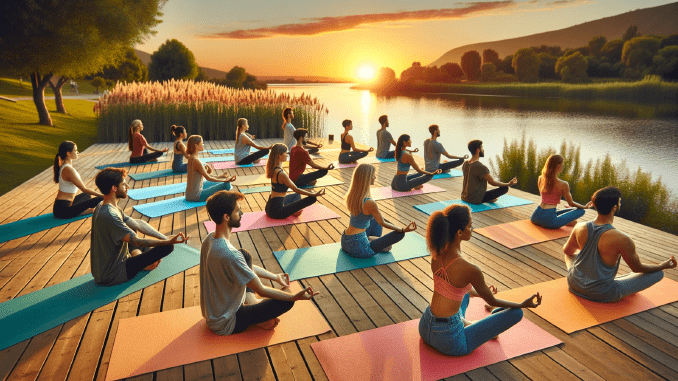
Setting up a yoga routine? Awesome! If you’re thinking about diving into the world of yoga, there are a few things to keep in mind. Let’s talk about developing a routine that not only keeps you fit and flexible but also keeps your mind at ease.
Importance of Consistency
First thing’s first: consistency. It’s not just about how many poses you can do or how long you can hold a plank. It’s about showing up on your mat regularly, even if it’s just for a few minutes each day.
Why? Because yoga is not just a physical activity—it’s a holistic practice that blends the body, mind, and soul. So, every time you step on that mat, you’re not just building physical strength; you’re cultivating mental discipline and resilience too.
Think about it. Remember the first time you tried to touch your toes and felt like they were miles away? But, with time and practice, it got easier, right? That’s the magic of consistency! Over time, your flexibility improves, your breathing gets deeper, and those difficult poses? Well, they don’t seem so hard anymore.
Warm-up Routines
But before you jump straight into the hero pose or a sun salutation, it’s crucial to get your body warmed up. Starting your practice with a proper warm-up ensures that your muscles are ready, which can help prevent injuries.
Here are a few warm-up ideas to get you started:
- Neck Rolls: Just drop your chin to your chest and gently roll your neck from side to side. This helps in releasing tension.
- Shoulder Shrugs: Lift your shoulders to your ears and then release. Feels good, right? Especially if you’re sitting at a desk all day.
- Gentle Twists: Sit in a comfortable, cross-legged position and twist your upper body from one side to the other. This warms up your spine and prepares you for more challenging twists later on.
Suggested Sequences for Beginners
Alright, now that you’re all warmed up, where to start? If you’re a newbie, the variety of poses might seem overwhelming. Here’s a simple sequence to get you started:
- Mountain Pose (Tadasana): This is your foundational pose. Stand tall and feel grounded. It’s more about feeling the pose than looking perfect.
- Forward Fold (Uttanasana): From Tadasana, bend forward from your hips and let your head hang. Feel the stretch in your legs.
- Downward Facing Dog (Adho Mukha Svanasana): This pose is great for stretching the whole body.
- Plank: A fantastic way to build strength in your arms and core.
- Child’s Pose (Balasana): This is a resting pose. It’s like a mini-break for your body and mind.
Start with these, and as you get more comfortable, you can add more poses to your routine.
Incorporating Meditation and Relaxation
Now, yoga isn’t just about twisting yourself into a pretzel. A significant component is about calming the mind. That’s where meditation and relaxation come into play.
End your practice with a few minutes of meditation. Just sit comfortably, close your eyes, and focus on your breath. You don’t need to clear your mind or achieve some deep state. Just breathe and be present.
RELATED: What is Meditation and how does it work?
And then there’s the ultimate relaxation: Savasana, or Corpse Pose. Lie down flat on your back, arms and legs slightly apart, and just relax. This pose gives your body time to absorb all the good work you’ve done during your practice.
Overcoming Common Challenges

Life can sometimes be a roller coaster, and the same can be said about embarking on a fitness journey. As you dive into a new routine or push to achieve those fitness goals, you may come across a few bumps along the way.
But hey, who said it was going to be easy? The real beauty of this journey is in conquering those challenges.
So, let’s dive into some of the common obstacles and ways to overcome them.
Addressing Flexibility Concerns
Starting off, there’s the big F-word: flexibility. No, not the kind you think about when negotiating with your boss for an extra vacation day. We’re talking about your body’s ability to move without restrictions.
Many feel that they aren’t flexible enough for certain exercises or routines, but here’s the deal: flexibility is not a prerequisite; it’s an outcome.
If you’re not flexible now, guess what? That’s why you start working on it!
- Start Slow: Begin with gentle stretches. Over time, as you consistently practice, you’ll notice an improvement in your flexibility.
- Warm Up: Before diving into any activity, ensure you’ve warmed up adequately. A good warm-up gets the blood flowing and makes your muscles more pliable.
- Consistency is Key: The more you stretch, the better you’ll get. So, make it a routine!
Avoiding Injury and Listening to Your Body
No pain, no gain, right? Wrong! While it’s natural to feel some discomfort when trying out something new, it’s essential to distinguish between ‘good’ pain, like muscle fatigue, and ‘bad’ pain, which could be a sign of injury.
- Educate Yourself: Knowledge is power. The more you understand about correct postures and techniques, the lower the chances of injury.
- Rest and Recover: Don’t go all out every single day. Your muscles need time to recover. It’s during this recovery time that they grow stronger.
- Listen to the Signs: If your body says it’s had enough, listen to it. There’s always tomorrow to push a bit harder.
Overcoming Self-Consciousness or Intimidation
Walking into a gym filled with people who seem to know exactly what they’re doing can be intimidating. But remember, everyone started somewhere.
And that ripped person doing a gazillion pull-ups? They, too, had their first day.
- It’s Your Journey: Instead of comparing yourself to others, focus on your progress. Celebrate the small victories.
- Seek Support: Join a beginner’s class or find a workout buddy. There’s strength in numbers.
- Focus on the Process: Instead of getting intimidated by how far you have to go, appreciate how far you’ve come.
Staying Motivated
We’ve all been there. The initial enthusiasm slowly wanes, and suddenly, the couch seems far more appealing than the gym.
Here’s how to keep that spark alive:
- Set Realistic Goals: Instead of aiming for the moon, set smaller, achievable targets. This way, you’re more likely to stick to your routine.
- Mix it Up: Routine can become monotonous. Change your workouts, try a new class, or set new challenges to keep things exciting.
- Reward Yourself: And no, we don’t mean with a giant tub of ice cream! Maybe a new workout outfit or a day at the spa? Treat yourself for the milestones you achieve.
To wrap things up, remember this: challenges are an inevitable part of any journey. They’re not there to break you, but to make you stronger.
Every time you overcome an obstacle, you’re one step closer to your goal. So, wear those challenges like badges of honor and keep pushing forward!
Integrating Yoga into Daily Life

Yoga is a holistic approach to life, blending mental clarity, physical strength, and spiritual depth. By weaving yoga into our everyday routines, we gift ourselves moments of calm amidst the chaos, anchoring our days with purpose and intention.
The beauty of yoga is that its benefits don’t just last for the duration of a session; they ripple outward, touching every aspect of our lives.
So, why not make yoga a daily companion and experience its transformative power firsthand?
Simple habits to cultivate mindfulness
Being mindful means being present. It’s all about tuning into the current moment, paying attention to the now rather than dwelling on the past or anxiously anticipating the future.
Here are a few habits to help you bring that yogic mindfulness into your daily routine:
- Deep Breathing: Just a minute of focused breathing can reset your mind. When overwhelmed, try inhaling for a count of four, holding for four, and exhaling for four. This simple act can center you.
- Mindful Eating: Instead of gulping down your food in front of a screen, try eating without distractions. Savor each bite, taste the flavors, and notice the textures. It not only enhances your dining experience but also improves digestion.
- Daily Meditation: Even if it’s just for five minutes, find a quiet space to sit comfortably, close your eyes, and focus on your breath. Over time, you’ll find your mind becoming clearer and more focused.
Yoga for stress relief and mental wellness
Modern life can be a whirlwind of tasks, commitments, and responsibilities. Yoga, with its emphasis on controlled breathing and bodily awareness, is a fantastic tool to combat stress and boost mental wellness. Here’s why:
- Poses and Flexibility: Asanas, or yoga poses, aren’t just physical exercises. They engage the mind by requiring focus and attention. The stretches relieve physical tension, while the concentration required keeps your mind off stressors.
- Pranayama and Breathing: Breathing techniques, or pranayama, are central to yoga. They regulate the body’s energy, calm the mind, and can even help with emotional regulation.
Yoga at work or during travel
You don’t need a dedicated studio or a 90-minute session to benefit from yoga. You can practice it wherever you are:
- Desk Yoga: Got a few minutes between meetings? Do a seated twist, stretch out your arms, or even do a gentle neck roll. These simple moves can rejuvenate you and counteract the stiffness from sitting too long.
- Travel Yoga: Long flights or car rides can be taxing. But simple stretches, like extending your legs or doing ankle rolls, can make a huge difference. And once at your destination, beginning your day with a quick sun salutation can help counteract jet lag and keep you energized.
Diet and nutrition in yoga philosophy
Yoga philosophy places a significant emphasis on a clean and balanced diet, as what you eat not only fuels your body but also your mind and spirit. Here are some guiding principles from the yogic dietary philosophy:
- Sattvic Diet: This is a diet that prioritizes fresh, organic, and wholesome foods. Think fruits, vegetables, grains, and nuts. Such foods are believed to promote clarity, happiness, and a peaceful mind.
- Avoid Tamasic Foods: Foods that are overprocessed, stale, or fermented are considered tamasic. They are believed to induce lethargy and mental dullness. So, that leftover pizza from three days ago? It’s probably best to skip it.
- Mindful Consumption: Being aware of where your food comes from, how it’s prepared, and the intention behind eating is vital. Eating should not just be about quelling hunger but also nourishing the body and mind.
Integrating yoga into your daily life goes beyond the mat. It’s about adopting a holistic approach that encompasses mind, body, and soul.
By bringing mindfulness, practicing yoga in different settings, and embracing the yogic philosophy in your diet, you’re well on your way to a balanced and harmonious life.
Joining the Yoga Community
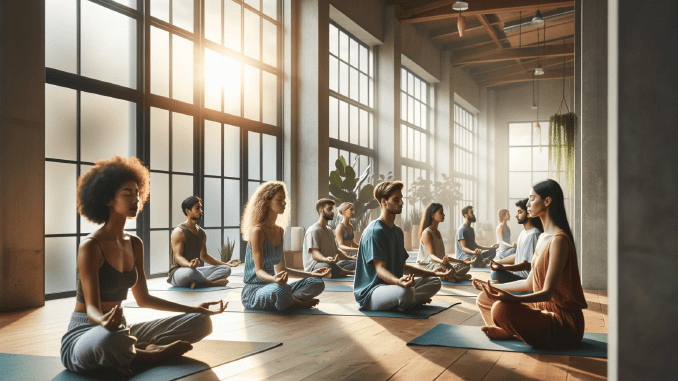
Have you ever seen someone doing a Downward-Facing Dog or Warrior II and thought, “Hey, I want to do that!”? Well, guess what? You absolutely can, and there’s a whole vibrant community out there waiting for you.
Diving into the world of yoga might seem a bit daunting at first, but with the right guidance and a little push, you’ll find it’s a journey worth taking.
Let’s explore why joining the yoga community can be a game-changer for you.
Benefits of Joining a Yoga Class
For starters, yoga is way more than just stretching on a mat. It’s an experience! Let’s go through some reasons why stepping into a yoga class might be the best decision you’ve made in a while:
- Physical health: Yoga tones your muscles, improves flexibility, and gives you a cardiovascular workout. So yes, you’re not just stretching but also building a stronger body.
- Mental wellbeing: Ever heard of the zen-like calm many yogis talk about? That’s real! Practicing yoga regularly can reduce stress and anxiety and even help improve sleep patterns. It’s a perfect recipe for mental tranquillity.
- Social connections: Joining a class isn’t just about the poses. It’s about the people you meet. Bond over that tricky Asana or share experiences after a meditation session. It’s like a little family waiting to adopt you!
Finding the Right Yoga Studio or Teacher
All yoga studios are not created equal. And the same goes for teachers. It’s crucial to find a place and a mentor that resonate with you. Here’s how:
- Do your research: Just like you wouldn’t buy the first pair of shoes you see, don’t just walk into any studio. Look for reviews, ask friends, or check out their websites.
- Attend trial classes: Most studios offer a trial class or a week of unlimited classes for newbies. This way, you can get a feel for the place, the teaching style, and the overall vibe.
- Connect with the teacher: After all, they’ll be guiding you on this journey. Ensure they have proper training and a teaching style that you vibe with. Remember, it’s okay to switch teachers until you find the one that’s right for you.
Yoga Retreats and Workshops
Want to dive deep? Consider yoga retreats or workshops. These are immersive experiences where you can:
- Deepen your practice: Work on advanced poses, delve deeper into meditation, or explore a new type of yoga.
- Connect with nature: Many retreats are in stunning natural locations. Think beaches, mountains, or forests.
- Make new friends: Nothing bonds people like shared experiences. A week at a retreat can forge friendships that last a lifetime.
Online resources and apps for beginners
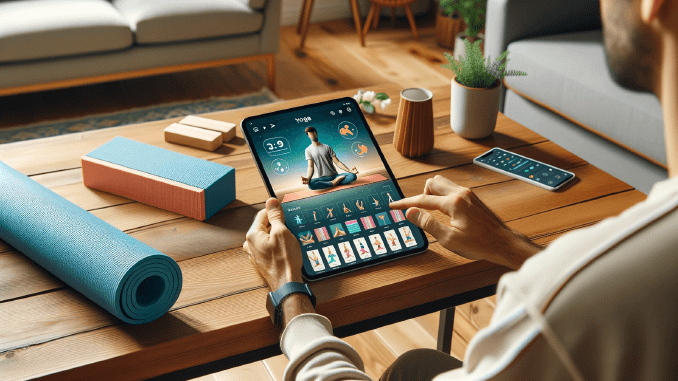
Navigating the vast world of yoga can be a bit overwhelming, but thanks to modern technology, there are countless resources at your fingertips. Here’s a list of reputable resources and apps that can guide you on your yoga journey:
- Yoga with Adriene on YouTube: Adriene Mishler has become a household name in the online yoga community. Her channel offers free, high-quality yoga classes catering to all levels. She has a vast collection, including videos for beginners, specific problems like back pain, and even themed series for challenges or particular goals.
- Down Dog App: This app is fantastic for its customization. Whether you’re a complete beginner or a seasoned yogi, you can tailor your practice based on level, duration, and specific focus. The app provides a new sequence every time, so you’ll never get bored.
- Daily Yoga App: A fan favorite among many. It provides more than 500 asanas, 200 guided classes of yoga, pilates, and meditation, plus 50 workout plans. It’s suitable for all levels and offers detailed voice instructions.
- Yogaia: It’s a unique platform because it offers live and interactive classes. This means you can get real-time feedback from instructors, a feature most apps don’t provide. It’s like having a yoga studio on your device.
- r/yoga on Reddit: For community support and sharing experiences, the yoga subreddit is a great place to start. From sharing advice and tutorials to personal experiences, it’s a hive of information.
- MyYogaWorks: This platform is an online extension of the popular YogaWorks studios. They offer a variety of classes and tutorials, all segmented by level, duration, and focus. While there’s a monthly fee, the structured and high-quality courses make it worthwhile.
But keep in mind that while all these resources are beneficial, the best way to understand what works for you is to try them out. Most apps offer a free version or trial period, so you can get a feel before committing. Dive deep, explore, and find what resonates with you. Happy practicing!
Progressing in Your Practice
When we talk about progressing in any discipline, there’s often an underlying implication that you’ve been there for a while, feeling the waters, and now aiming to dive deeper.
Yoga, much like any journey, starts with a single step, often the toughest. But once you start moving, how do you go from paddling in the shallows to diving into the depths?
Let’s journey together into the realms of setting yoga goals, delving into advanced techniques, and even dipping our toes into some of yoga’s intriguing specializations.
Setting and Achieving Yoga Goals
You wouldn’t set out on a road trip without a destination or at least a vague idea of where you want to go, right? Similarly, when deepening your yoga journey, setting clear intentions can help guide your practice and keep you motivated. Here are some steps to get started:
- Clarify Your Intention: Before anything else, understand why you’re practicing yoga. Is it for flexibility, strength, relaxation, spiritual growth, or something else?
- Be Specific: Instead of a vague “I want to be more flexible,” aim for something tangible, such as “I’d like to master the Downward Dog in three months.”
- Stay Consistent: Rome wasn’t built in a day, and neither is a strong yoga practice. Setting a consistent routine helps you achieve your goals.
- Track and Celebrate Progress: It’s important to recognize even the smallest improvements. This keeps morale high and propels you forward.
Deepening Your Practice with Advanced Postures and Techniques
Once you’re familiar with the basics, there’s a vast ocean of advanced postures and techniques waiting to be explored. Here’s how you can progress:
- Learn from a Mentor: Finding an experienced teacher can be invaluable. They can provide guidance tailored to your needs and help you avoid common pitfalls.
- Engage in Workshops and Retreats: Immersive experiences can boost your understanding and expose you to various styles and practices of yoga.
- Introduce Pranayama and Meditation: Yoga isn’t just about postures. Breathing exercises (Pranayama) and meditation can deepen your practice and connect you with your inner self.
Exploring Specializations
Yoga, in its expansive grace, offers myriad styles and specializations. Let’s explore a couple:
- Yoga Nidra: Often referred to as “yogic sleep,” Yoga Nidra is a guided meditation that can lead to profound relaxation and transformation. It’s not about physical movement but about sinking into a deep state of consciousness.
- Chakra Yoga: If you’re fascinated by the energy centers of the body, Chakra Yoga is your realm. It focuses on activating and balancing the seven chakras, helping to optimize your physical, emotional, and spiritual well-being.
But these are just the tip of the iceberg. As you delve deeper, you might come across Kundalini Yoga, Prenatal Yoga, Acro Yoga, and so much more. Each style offers a unique perspective and approach, and you might find one that resonates deeply with you.
Conclusion
Ah, yoga. For many, the word immediately brings to mind images of serene faces, flexible bodies, and Instagram-worthy poses on pristine beaches.
But anyone who’s ever delved deeper into the world of yoga knows it’s so much more than those picture-perfect moments.
It’s a lifelong journey, one that has the power to transform not just our bodies but our minds and souls as well.
The Lifelong Journey of Yoga
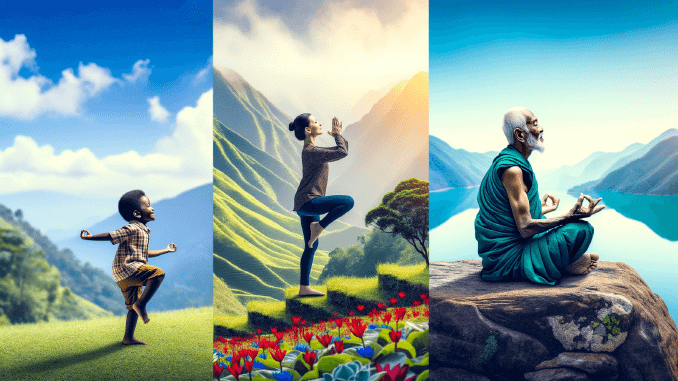
When one embarks on the path of yoga, it’s not just a foray into a physical practice. No, it’s a commitment to oneself, to growth, and to a deeper understanding of the universe. Just like life, the journey of yoga is filled with highs and lows.
There will be days when the poses come easily, where you feel invincible, aligned, and in tune with everything. And then, there’ll be days when even the simplest of poses will seem like insurmountable mountains.
However, what’s essential is not the perfection of a pose or attaining that ideal body. It’s the experience, the awareness, and the transformations that occur over time. As the years roll by, those who stick with it find that yoga offers lessons that apply both on and off the mat.
It teaches patience, resilience, humility, and self-acceptance. It shows that growth is a continuous process, and there’s always room for improvement.
Yoga as a Way of Life, Beyond the Mat
The beauty of yoga is that its principles aren’t confined to the mat. Sure, the physical practice is beneficial. It keeps our bodies strong, flexible, and healthy. But the true magic happens when we take the teachings of yoga and apply them to our everyday lives.
Consider the principles of Ahimsa (non-violence) or Satya (truthfulness). These aren’t just guidelines for how to behave during a yoga class. They’re directives for life. Being truthful, kind, and non-judgmental in our day-to-day interactions can bring about a profound positive change in our relationships and overall well-being.
Furthermore, mindfulness, a cornerstone of yoga, is immensely beneficial when applied to our daily activities. Whether you’re eating, working, or simply taking a stroll, being fully present can elevate that experience. This level of awareness and intentionality turns even mundane tasks into acts of meditation.
Consistent Practice and Learning
Like any worthwhile endeavor, consistency is key in yoga. It’s not about how advanced your poses are or how long you can meditate without a wandering thought. It’s about showing up, day after day, with an open heart and mind. Some days, you’ll make progress, and other days, it’ll feel like you’re moving backward. But every single day, you learn.
The world of yoga is vast. From the physical postures (asanas) to the philosophical teachings, there’s always something new to explore. That’s why it’s vital to approach yoga with the mindset of a perpetual student. Whether it’s attending workshops, reading ancient texts, or simply conversing with fellow yogis, the opportunities to deepen your understanding are endless.
Even the most experienced practitioners will tell you they’re still learning. That’s the beauty of it. Yoga doesn’t have an endpoint. It’s an ongoing journey, filled with endless discoveries and boundless possibilities.
So, whether you’re a seasoned yogi or someone who’s just started their journey, remember this: yoga is not just a practice; it’s a way of life. Embrace it wholeheartedly, stay consistent, remain curious, and watch how it enriches every facet of your existence.
Appendix: Glossary of Common Yoga Terms
Whether you’re just starting your journey into the world of yoga or you’re a seasoned yogi looking to refresh your knowledge, there’s no denying that the terminology can sometimes be a tad confusing.
Yoga has its roots in ancient India, and thus, many of its terms are derived from the Sanskrit language.
But fear not! This glossary is here to break down the most commonly used yoga terms in simple and plain language. Let’s dive in:
1. Asana: This is probably a term you’ll hear quite often. Asana simply refers to the physical poses or postures practiced in yoga. So when you’re doing that downward dog or warrior pose, you’re engaging in asana.
2. Chakra: Chakras are believed to be energy centers within the body. There are seven main chakras that run along the spine, starting at the base and going up to the crown of the head. Each chakra is associated with specific qualities and attributes.
3. Dhyana: Meditation. It’s the practice of focusing the mind and finding stillness. Dhyana is one of the eight limbs of yoga and is all about connecting with oneself on a deeper level.
4. Mantra: A word, sound, or phrase that’s repeated during meditation. Mantras can be used to aid concentration and to set an intention for the practice.
5. Namaste: You’ll often hear this at the end of a yoga class. It’s a traditional Indian greeting that means “The divine in me honors the divine in you.” It’s a way of showing respect and gratitude.
6. Pranayama: This term refers to breath control practices in yoga. Breathing is essential to life, and in yoga, it’s used to connect the body and mind. Pranayama exercises can be calming or energizing, depending on the technique.
7. Savasana: Often called the corpse pose, this is typically the final pose of any yoga practice. You lie flat on your back, close your eyes, and relax. It’s a time for the body to integrate the benefits of the practice.
8. Ujjayi: This is a specific breathing technique often used in yoga. It’s sometimes called “ocean breath” because of the sound it makes. To do it, you breathe in and out through the nose, constricting the back of the throat slightly to create a gentle, audible breath.
9. Vinyasa: This term often refers to a style of yoga where movements flow from one pose to the next, synchronized with the breath. Think of it as a dynamic dance where each movement is linked to the rhythm of breathing.
10. Yogi/Yogini: A male or female practitioner of yoga. So if you’re doing yoga, congratulations! You’re a yogi (or yogini)!
11. Sutra: These are ancient texts or guidelines that talk about the philosophy and practice of yoga. The most famous is “The Yoga Sutras of Patanjali,” which outlines the path to spiritual enlightenment.
12. Mudra: Gestures or hand positions often used in meditation and pranayama. They are believed to influence energy flow in the body.
13. Drishti: The focal point where one’s gaze rests during asana practice. It helps with concentration and balance.
There you have it—a simple rundown of some of the most common terms you might come across in the realm of yoga.
Happy stretching!







